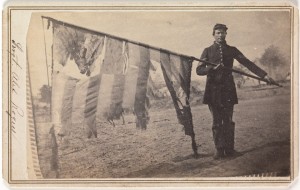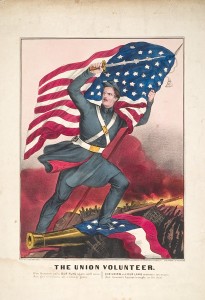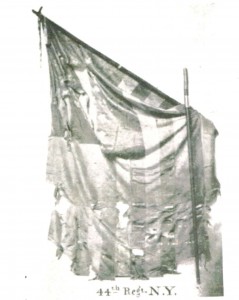‘Scars of honor and not disgrace’
By James Breig

During the Civil War 150 years ago, flag-bearers were targets. On battlefields from Gettysburg to Petersburg, they were in the crosshairs of their opponents.
The reason for that is that they played such a pivotal role when a battle was joined. Soldiers looked to flags, including their regimental colors, to show them where to go. Shouted commands were overwhelmed by blasts of guns and cannon; gestures to point the way were clouded by gun smoke.

It was up to the men holding flagpoles to guide their fellow soldiers to the right spot at the right time. To the foe, therefore, stopping the flag-bearer meant sowing confusion. It is a measure of their importance that Congressional Medals of Honor were given to hundreds of Union flag-bearers for their courage in battle.
An example was Corporal Nathaniel Allen from the 1st Massachusetts, who fought at Gettysburg. Already responsible for bearing Old Glory, he pulled the regimental flag “from under the body of its bearer, who had fallen,” and saved it “from capture and brought both colors off the field.”
In “A History of the Forty-Fourth Regiment, New York Voluntary Infantry,” Captain Eugene Arus Nash reflected on heroic flag-bearers who stood against the onslaught of musket balls.
Take this report about the Battle of Hanover Court House in Virginia in May 1862: “Corporal James Young of Company F raised the colors twice from the ground and was twice shot down. Samuel W. Chandler of Company F, who had been wounded in the leg and arm, with wounds bleeding, crept to the flag-staff and with great effort raised it the third time. In a moment he, too, was shot in the breast and fell. Frank B. Schutt of Company G then raised it. The flag was pierced by forty bullets.”

During a battle two months later, Nash recorded how one man acted heroically in the middle of the confusing din of a fight. “I desire,” he wrote, “especially to commend…the gallant conduct of Private James B. Hitchcock of Company K, who, after four color bearers had been shot down, asked permission to carry the colors, and though subsequently wounded twice, refused to resign the flag into any other hands than those of the Commanding Officer who had entrusted it to him.”
When a new silk banner was presented to his unit in 1863, Nash described the condition of its predecessor: “Its beautiful folds had been torn by the murderous missiles of war, its staff cut in twain, its sacred field crimsoned with the blood of heroes, but these were scars of honor and not of disgrace.”
